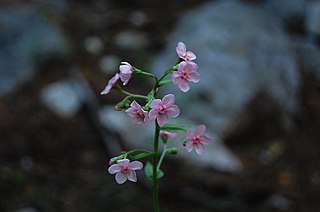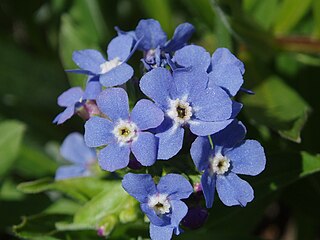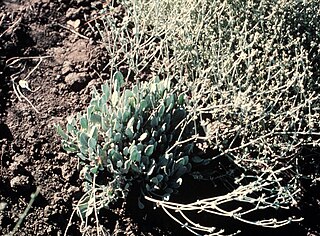
Erigeron eatonii is a North American species of flowering plants in the daisy family known by the common name Eaton's fleabane.
Hackelia bella is a species of flowering plant in the borage family known by the common name greater showy stickseed.

Hackelia californica is a species of flowering plant in the borage family known by the common name California stickseed.

Hackelia floribunda is a species of flowering plant in the borage family known by the common names large-flowered stickseed and manyflower stickseed.

Hackelia micrantha is a species of flowering plant in the borage family known by the common names Jessica sticktight and Jessica's stickseed.

Hackelia mundula is a species of flowering plant in the borage family known by the common name pink stickseed. It is native to the high mountains of California, especially the Sierra Nevada. Its range may extend into Oregon. This is a lush, hairy perennial herb growing to maximum heights between 40 and 80 centimeters. It produces an array of erect stems with oval- or lance-shaped leaves most abundant around the bases, growing up to 22 centimeters long. The upper stems are mostly leafless and hold cyme inflorescences of flowers. Each petite flower has 5 rounded lobes which are light pink and age to light blue in color, each with a smaller petallike appendage at its base. The fruit is a small nutlet covered in thin, hairlike prickles.

Hackelia nervosa is a species of flowering plant in the borage family known by the common name Sierra stickseed. It is native to the mountains of California, especially the Sierra Nevada and its foothills, in areas with some moisture up to near treeline. Its range may extend into Nevada.

Hackelia velutina is a species of flowering plant in the borage family known by the common name velvet stickseed.
Hackelia amethystina is a species of flowering plant in the borage family known by the common name amethyst stickseed.
Hackelia brevicula is a species of flowering plant in the borage family known by the common name Poison Canyon stickseed.
Hackelia cusickii is a species of flowering plant in the borage family known by the common name Cusick's stickseed.
Hackelia setosa is a species of flowering plant in the borage family known by the common name bristly stickseed. It is native to the Klamath Mountains of northern California and southern Oregon and it is also known from Sierra Valley to the southeast of that range. It grows in open and wooded habitat. It is a hairy perennial herb up to about 60 centimeters tall. Most of the leaves are located around the base of the plant, reaching up to 22 centimeters long. Leaves higher on the stem are shorter and narrower. The hairy inflorescence is an open array of branches, each a coiling panicle of white-throated blue flowers. The fruit is a cluster of prickly nutlets.
Hackelia venusta is a rare species of flowering plant in the borage family known by the common name showy stickseed, or lesser showy stickseed. It is endemic to Washington state in the United States, where it is known from only one canyon in Chelan County. There is only one small population with a global distribution of less than one hectare. The plant was federally listed as an endangered species of the United States in 2002.
Thelypodium eucosmum is a species of flowering plant in the mustard family known by the common names arrow-leaf thelypody and world thelypody. It is endemic to Oregon in the United States, where it is known from Grant and Wheeler Counties. There are also historical records of the plant from Baker County.

Eriogonum niveum is a species of flowering plant in the buckwheat family known by the common name snow buckwheat. It is native to the Pacific Northwest of North America, where it occurs in British Columbia, Washington, Oregon, and Idaho.

Eriogonum thymoides is an "abundant" species of flowering plant in the buckwheat family known by the common name thymeleaf wild buckwheat, or simply thymeleaf buckwheat.
Carex aboriginum is a species of sedge endemic to Idaho in the western United States, known as Indian Valley sedge. It was not observed in the wild between 1910, when it was first described, and 1999. Until its rediscovery, C. aboriginum was considered the only plant native to Idaho to have become extinct, and it remains one of the state's rarest and most endangered plant species.

Physaria tumulosa is a rare species of flowering plant in the family Brassicaceae known by the common name Kodachrome bladderpod. It is endemic to Utah in the United States, where it is known only from Kane County. There is only one known population of this plant made up of scattered occurrences totalling about 20,000 individuals, all within the Kodachrome Basin. The plant is threatened by the loss and degradation of its habitat. It is federally listed as an endangered species. It was previously treated as a subspecies of Physaria hitchcockii.

Peniocereus striatus is a species of cactus known by several common names, including gearstem cactus, cardoncillo, jacamatraca, sacamatraca, and dahlia-rooted cactus. It is endemic to the Sonoran Desert, where it occurs in Baja California, Sinaloa, and Sonora in Mexico and Arizona in the United States.
Erigeron cronquistii is a rare North American species of flowering plants in the daisy family known by the common name Cronquist's fleabane. It has been found only in the Bear River Range in Cache County in the northern part of the state of Utah in the United States.












